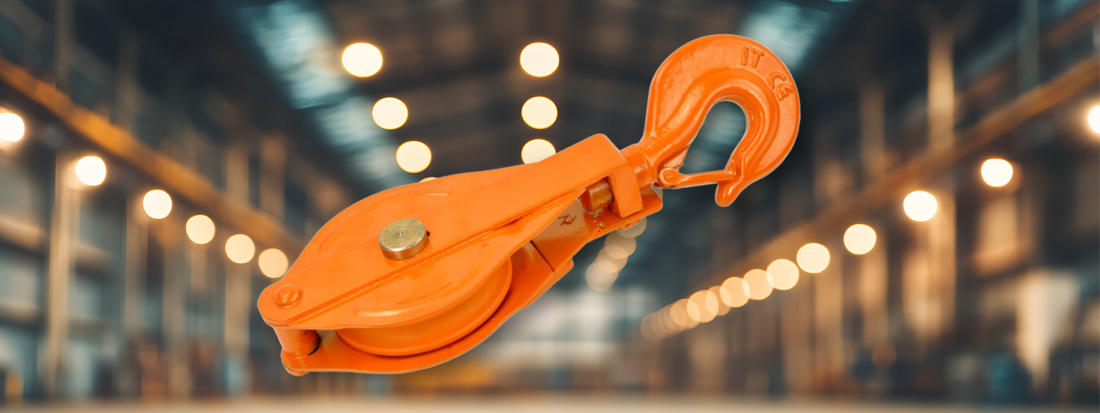
From Force to Safety: Why Snatch Blocks Are Essential in Rigging
In heavy lifting, rigging, and crane operations, efficiency and safety are paramount. One deceptively simple tool that delivers both is the snatch block. Whether you’re redirecting a cable, increasing mechanical advantage, or managing load alignment, a snatch block can be a game changer.
In this article, we’ll dive deep into what a snatch block is, how it works, when to use it, and best practices for safe operation. If you're in the market for lifting hardware, Hercules Crane & Lifting Supplies is here to help you get the exact block you need—on time, every time.
What Is a Snatch Block?
A snatch block is a type of pulley (or sheave block) that opens on one side, allowing you to insert a rope, cable, or wire without threading it through an eye. Unlike fixed pulleys, snatch blocks are convenient to insert mid-line (hence “snatch”) and can redirect force, reduce friction, or distribute load across multiple lines.
The essential components of a snatch block include:
-
Sheave / wheel — the rotating grooved wheel the rope rides on
-
Side gate or openable jaw — lets you insert or remove rope midline
-
Frame / housing — which carries the load and protects the sheave
-
Hook, shackle, or swivel connection point — for anchoring or connecting
Depending on the design, snatch blocks may have single or multiple sheaves, fixed or swivel heads, and varied load capacities.

How Snatch Blocks Work & Their Mechanical Advantage
At the heart of a snatch block’s utility is its ability to reduce load force via mechanical advantage and change direction of applied force. Here are two common applications:
-
Load Deflection / Redirection
Want to redirect a pull around a bend or obstacle? A snatch block can route your wire rope around a corner, preserving your pull force while guiding the line properly. -
Mechanical Advantage / Block & Tackle Systems
Pairing a snatch block with another block (or using multiple snatch blocks) creates a block-and-tackle setup. This gives you mechanical advantage—meaning you can lift heavier loads with less input force. For example, a simple double-sheave configuration can halve the effort needed (ignoring friction).
Keep in mind: friction in the sheaves and bearings reduces actual efficiency. Always check manufacturer specs for efficiency ratings in pulley assemblies.
When & Why to Use a Snatch Block
Here are some typical use cases and benefits for snatch blocks in lifting and rigging:
-
Change Line Direction — Maneuver around obstacles or reposition load paths
-
Increase Lifting Capacity — In block-and-tackle, magnify lifting force
-
Reduce Wear — Spread out wear on the rope by guiding it through a sheave
-
Ease Rigging Adjustments — Mid-line insertion without disconnecting the rope
-
Improve Safety — Better line alignment and controlled load paths
In crane operations, snatch blocks are often used for deflection sheaves (redirecting cable winding), rigging adjustments, and temporary line rerouting. In arboriculture, forestry, and rescue, they’re used for redirecting lines with minimal friction and rapid reconfiguration.
Types, Designs & Selection Criteria
Choosing the right snatch block depends on your usage, load requirements, and environment. Key factors include:
-
Working Load Limit (WLL) — Always select a block rated above your maximum applied load
-
Sheave Diameter & Ratio — Larger diameters reduce bending stress on the rope
-
Number of Sheaves — Single, double, triple — more sheaves = more flexibility and mechanical advantage
-
Connection Style — Hook, shackle, swivel, or pin attachment
-
Bearing Type — Roller, ball, or plain — affects friction and efficiency
-
Materials & Finish — Steel, forged alloy, or aluminum; corrosion-resistant finishes for marine or outdoor use
-
Gate / Opening Mechanism — latch, pin, or bolt closure to safely secure the rope
For heavy crane and rigging applications, Hercules Crane & Lifting Supplies stocks blocks from top manufacturers, offering high WLL ratings, reliable bearings, and durable finishes to stand up to harsh conditions.
Safety Guidelines & Best Practices
Using snatch blocks safely is essential to protect your crew, equipment, and materials. Here are some recommended best practices:
-
Inspect regularly — check sheaves, bearings, frames, gate closures
-
Match block rating to job — never exceed WLL
-
Maintain proper rope wrap / angle — avoid excessive bending or improper seating
-
Lubrication & maintenance — keep bearings and sheaves in good condition
-
Avoid side loading — apply load in line with the sheave direction
-
Secure open gate closures — ensure latch or pin is fully engaged
-
Use snatch blocks of correct size — sheave diameter should be ≥ 20× the rope diameter (as a rule of thumb)
-
Factor friction losses — account for 5–15% losses in mechanical advantage
-
Wear protective gear — gloves, eye protection, etc., when rigging
By following these guidelines, snatch blocks become dependable tools rather than risk points.
Industry Applications
Construction / Overhead Crane Systems
Snatch blocks act as deflection sheaves to guide cable reeving paths, reduce side pull, and optimize drum wraps.
Forestry & Logging
Used to reroute cables around trees or stumps, facilitating directional pulling with less friction and safer line paths.
Rigging & Specialty Lifting
Creating mechanical advantage systems for lifting heavy machinery, structural components, or awkward loads.
Rescue & Recovery
Quickly adaptable in rescue scenarios (rope rescue, vehicle recovery) where mid-line insertion and reconfiguration save time.
Integrating Snatch Blocks into Your Operation
-
Assess your load and path — define your lifting or redirect needs
-
Select an appropriate snatch block — based on WLL, sheave size, connection style
-
Plan your rigging layout — sketch block placement and rope path
-
Install & test with light load — verify alignment, movement, and closure security
-
Perform final lift or pull — monitor for overheating, slack, or abnormal wear
-
Post-use inspection & maintenance — clean, lubricate, and store properly
Hercules Crane & Lifting Supplies can help at every step—from specifying the right snatch block to supplying spares and conducting inspections. Our experts are ready to support your lifting operations with the right gear and engineering advice.
Why Choose Hercules Crane & Lifting Supplies?
-
Industry-grade inventory: We stock a full line of snatch blocks, sheave blocks, rigging gears, and lifting hardware
-
Expert support: Our team understands crane, rigging, forestry, and industrial requirements
-
Certifications & traceability: All our lifting gear comes with test certifications and documentation
-
Fast delivery across Canada: Minimize downtime with prompt shipping
-
Safety-first philosophy: We provide training insights and safety best practices
Let Hercules Crane & Lifting Supplies be your go-to partner for safe, efficient, and high-performance rigging. Contact us today for all your rigging requirements.




